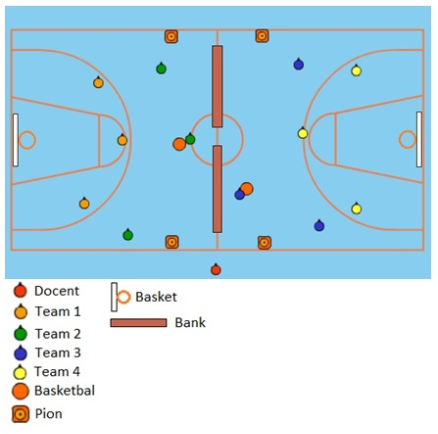Basketball drills for technique dribbling
- In the speed dribble, the upper body makes an angle of less than 90 degrees with the ground.
- This is highly dependent on the speed at which the dribble is performed. The higher the speed, the smaller the angle.
- The dribbling arm is directed more forward due to the speed.
- The dribble is between hip and chest height; the ball is pushed powerfully to the ground and lands next to the shoulder axis in front of the feet.
- If there are no defenders around, the free arm has a balancing function
- If this is not the case, the dribbler will initially try to increase his speed in order to shake off the defender
- If this does not work, he can use his free arm to prevent the opponent from taking the ball.
- Obviously, this will be at the expense of speed.
- The walking speed must be in accordance with the dribbler's level; walking and dribbling must not hinder each other.
- The knees and ankles are bent strongly during the low dribble, allowing the ball to stay extra low to the ground.
- The torso and head, on the other hand, remain practically straight.
- The gaze is directed towards the opponent(s) and the rest of the field of play
- The free (slightly bent) arm is turned towards the opponent and has a protective function.
- If the situation requires, the body is brought between the opponent and the ball.
- Bringing the ball up to the attacking half.
- Fast break.
- When the way to the basket is clear.
- One-on-one situations.
- Drive, between defenders.
- Freeing up to get into a better shot position or passing opportunity.
- Escape from a situation where passing is simply not possible and the ball must be protected.
- Players are spread out in the room; everyone has a ball.
- The ball is held between the legs with two hands. The right hand is in front of the body and the left hand behind the body.
- The ball must be prevented from falling to the floor by changing hands very quickly.
- Attacker/defender start just right of midcourt next to each other.
- Attacker starts on the right.
- Passer behind (coach if necessary). Lob pass, roll or other.
- free play on 1 or 2 baskets, depending on the number of players.
- PURPOSE: Quick passing, cutting, helpside, ballside, boxing-out.
- First team at 5.
- Loser push-ups 6.
- Circle the ball alternately around: hips, thighs, knees, calves, ankles, chest, head.
- Foot Stride; circle the ball first around the different parts of the front leg, then the back leg.
- Spreading stance; same as previous exercise.
- As previous exercise. After each circle alternate with the other leg.
- Eight circle.
- Alternate between squatting and standing while dribbling.
- Dribble while sitting down and standing up again.
- Dribble while lying on your back; stand up while dribbling at the signal.
- Dribble while lying down and standing up again.
- Everyone has a ball stands on the sideline.
- Exercises are alternated with
- crossover,
- between the legs
- etc.
- The teacher divides the room into two squares by placing benches on the centerline of the room.
- Then the teacher makes 2 squares with pawns to catch up the right of attack.
- During this game the rulebook is used.
- See module basketball for this guide.
- The teacher divides the students into teams of 3, possibly with a substitute.
- See the tables at the bottom of the lesson preparation for the game schedules.
- The intention is that the team that has the ball (on the map team 2 & 3) try to score.
- To be able to score, the team must first get the right of attack.
- They get this right of attack when they arrive with the ball in the area of the pawns.
- From now on the team may score.
- They do this by shooting the ball into the basket.
- The other team must try to take the ball away from them.
- When this happens, the teams swap roles and the new team with the ball has to get the right of attack and try to score.

- We're gonna dribble!
- Dribble the ball from left to right.
- With feints in between. High. Low. Fast and slow.
- Look closely at the options you have.
- The planet Saturn is the planet with the rings.
- So can you guess how the Saturn exercise goes?
- Spin the ball around your left leg, your right leg and around both legs.
- There is no dribbling involved, but this exercise is very good for your hand-eye coordination.







